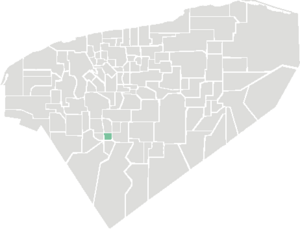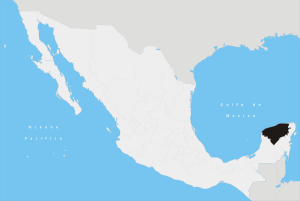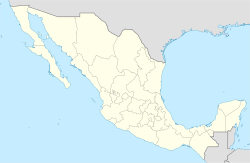Maní, Yucatán facts for kids
Quick facts for kids
Maní
|
|
|---|---|
|
City
|
|

Church and Convent of San Miguel in Maní
|
|

Location of the municipality of Maní in Yucatán
|
|

The state of Yucatán, México (dark) in the Yucatán Peninsula
|
|
| Country | |
| State | |
| Municipality | Maní Municipality |
| Elevation | 26 m (85 ft) |
| Population
(2010)
|
|
| • Total | 4,146 |
| Demonym(s) | Maniense |
| Time zone | UTC-6 (Central Standard Time) |
| • Summer (DST) | UTC-5 (Central Daylight Time) |
| Postal Code |
97850
|
| Area code(s) | 997 |
Maní is a small city in the Mexican state of Yucatán. It's located in the central part of the Yucatán Peninsula. Maní is about 100 kilometers (62 miles) southeast of Mérida, Yucatán, a larger city in Yucatán.
Today, about 4,000 people live in Maní, which is similar to its population in the 1500s. In 2021, Maní was named a 'Best Tourism Village.' This award celebrates towns that do a great job protecting their history and nature for visitors. Maní was the first town in Yucatán to get this special award!
Contents
Maní's Long History
Maní has a long and interesting history, going back about 4,000 years! It was first a big part of the ancient Maya civilization. Later, it became important during the time of the Spanish conquistadors. More recently, it has been part of Mexico's history.
Early Maya Times
Maní has been lived in for about 4,000 years without stopping. In ancient times, after the Classic Maya period, it was home to the Tutul-Xiu Maya family. They moved their capital city here from Uxmal in the 1200s. The Xiu family became very powerful in western Yucatán after the city of Mayapan fell in 1441. Maní was a main religious center where people honored the god Kukulcan. They held an annual festival called chic kaban until 1341.
When the Spanish arrived, the Xiu family of Maní decided to become allies with them. They helped the Spanish conquer the rest of the Yucatán Peninsula.
The Burning of Maya Books
On July 12, 1562, a Spanish friar named Diego de Landa held a special ceremony in Maní. He was an inquisitor, which meant he had the power to investigate and punish people for religious reasons. During this ceremony, he burned many Maya hieroglyphic books. He also reportedly burned about 5,000 idols, saying they were "works of the devil."
The exact number of books burned is debated, but Landa himself claimed to have burned 27. This act, along with other harsh actions, was used to make people quickly adopt the Roman Catholic religion in the area. Landa wrote about burning these sacred books with Maya writing. He said, "We found a large number of books in these characters and, as they contained nothing in which were not to be seen as superstition and lies of the devil, we burned them all, which they (the Maya) regretted to an amazing degree, and which caused them much affliction."
The Caste War of Yucatán

Maní was also involved in a long conflict called the Guerra de Castas, or Caste War of the Yucatán. This war lasted for many years. An engraved stone in Mérida, Yucatán tells about an event that happened in Maní during this war in 1850.
Church and Convent of San Miguel
| Historical population | ||
|---|---|---|
| Year | Pop. | ±% |
| 2000BC | initial | — |
| 16th century AD | 4,500 | — |
| 2000 | 4,664 | +3.6% |
| 2005 | 3,915 | −16.1% |
| 2010 | 4,146 | +5.9% |
| INEGI: Archivo Histórico de localidades | ||
The town of Maní has an old Franciscan monastery called the Parroquia y Exconvento de San Miguel Arcangel. It was built in 1549. This large building was made using stones taken from many of the older Pre-Columbian Maya structures in Maní.
On the north side of the church, there is a large open chapel. The church's front has two bell gables. Inside, the apse (the curved part at the end of the church) has old fresco murals from the early colonial period. The main part of the church, called the nave, holds three Baroque altars. These altars are carved and have statues of saints and other religious images. Work to restore the monastery building and its artwork began in 2001.
What's Around Maní
The land around Maní is mostly used for farming. Farmers grow henequen (a plant used to make fiber), maiz (corn), and fruit. They also raise cattle. In the city itself, people are known for making Hammocks.
Maní's Festivals
Maní holds two main festivals each year:
- Every year from August 15 to 24, Maní celebrates a festival in honor of the Virgin of the Assumption.
- On January 3, there is another festival for the Virgin of Candlemas.
Images for kids
See also
 In Spanish: Maní (Yucatán) para niños
In Spanish: Maní (Yucatán) para niños









